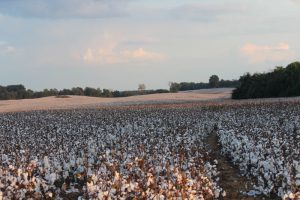
Vaden Farms in Lauderdale County, Alabama, grows corn and cotton on more than 5,000 acres. Their corn crop is mainly sold to poultry feed mill processors and their cotton ends up in domestic and international textile mills and yarn manufactures.
By Cassondra Searight, Public Affairs Specialist, Alabama Farm Service Agency
Many producers strive to grow healthy food for their family, neighbors and the U.S. population. Vaden Farms in Lauderdale County, Alabama, operated by Randall and Tami Vaden with the help of Randall’s parents, James and Gail Vaden, is one of the many examples of local farm families producing food, fiber and a story of success.
As Randall sat in his community college classroom in the spring of 1996, he craved to be outside in the sun. He wanted a career path that would challenge him, break monotony and provide new opportunities and adventures daily. He decided to return home to pursue a career in agriculture full-time.
Randall began farming with his parents who own 80 acres of land, but farm a total of 900 acres, including leased land. Cotton and corn were the family staple and Randall wanted to reduce labor and input costs. He worked diligently researching new agriculture trends, finding and developing new markets, and along the way, married the love of his life, Tami.
Randall and Tami have been married for 15 years. They are the principal owners and operators of roughly 2,600 acres in Florence, Alabama, and lease an additional 2,700 acres. Tami manages the Scruggs and Vaden Gin Company in Lauderdale County. The family operation continues to grow cotton and corn in the Oakland and Rhodesville communities.
Randall attributes the operation’s success to crop rotation coupled with the use of crop residue, cover crops and no-till farming.
“No-till farming reduces the amount of labor needed and reduces the emission of potential harmful greenhouse gases,” said Randall.
Crop rotation helps with erosion and crop residue increases water retention of the soil, which prevents the runoff of contaminated water, and also reduces the amount of water needed for the next crop. Cover crops are a huge contributor to providing the land with necessary nutrients without the addition of excessive fertilizers and chemicals. Wheat and rye are the Vaden’s current cover crops of choice, but they are considering adding radish, clover, mustard and turnips.
The cotton produced by Vaden Farms is ginned at the Scruggs & Vaden Gin Company. From there, the cotton is primarily sold to Cargill, Allenberg and Choice Cotton buyers. These buyers purchase locally grown cotton for distribution both domestically and internationally to textile mills and yarn manufacturers. The Vaden’s carefully monitor commodity prices and participate with formed agriculture cooperatives to determine when cotton is sold and contract purchase prices.
Corn produced on the farm is sold to Tyson, Pilgrim’s Pride, Mar-jac, and Wayne Farms fully integrated poultry feed mill processors. These processors purchase locally-grown corn for the feed mix provided to poultry contract growers in Alabama and surrounding states. Corn makes up the vast majority of this feed mix, but it also contains soybeans, oats, and other grains and legumes. The Vadens also sell a small portion of harvested corn to Meow Mix, to be used as cat food.
As consumer demand for local products rises, U.S. farmers and ranchers like Randall and Tami are working to meet the demand by creating local markets for their products and USDA is working hard to introduce these family farmers and ranchers to the American consumer.
Between 2009 and 2015, USDA invested over $1 billion in more than 40,000 local and regional food businesses and infrastructure projects.
For more information about local food and markets visit http://www.usda.gov/wps/portal/usda/knowyourfarmer?navid=kyf-kyf. For more information on FSA programs and loans visit http://www.fsa.usda.govor contact your local FSA office. To locate an office, visit http://offices.usda.gov.






One Response to Alabama Farm Family Turns Food and Fiber into Story of Success